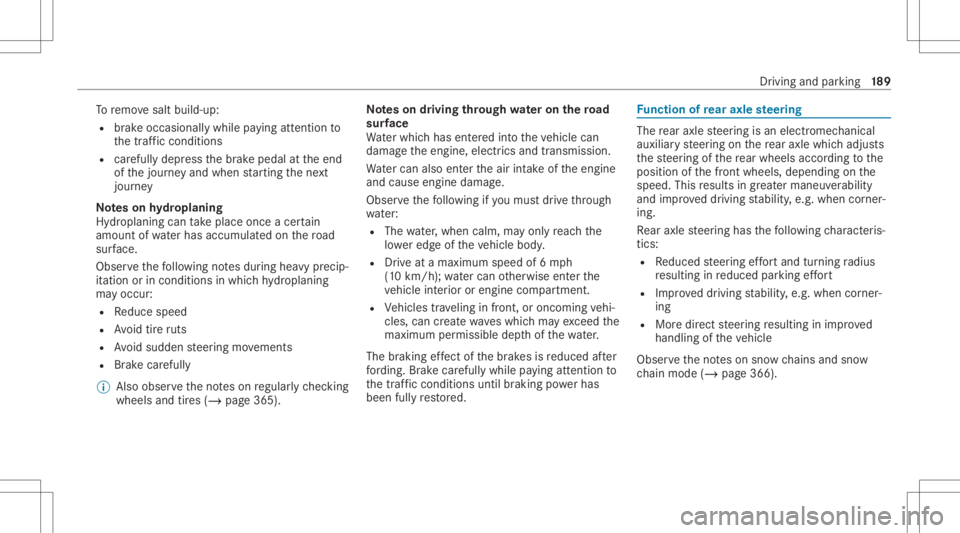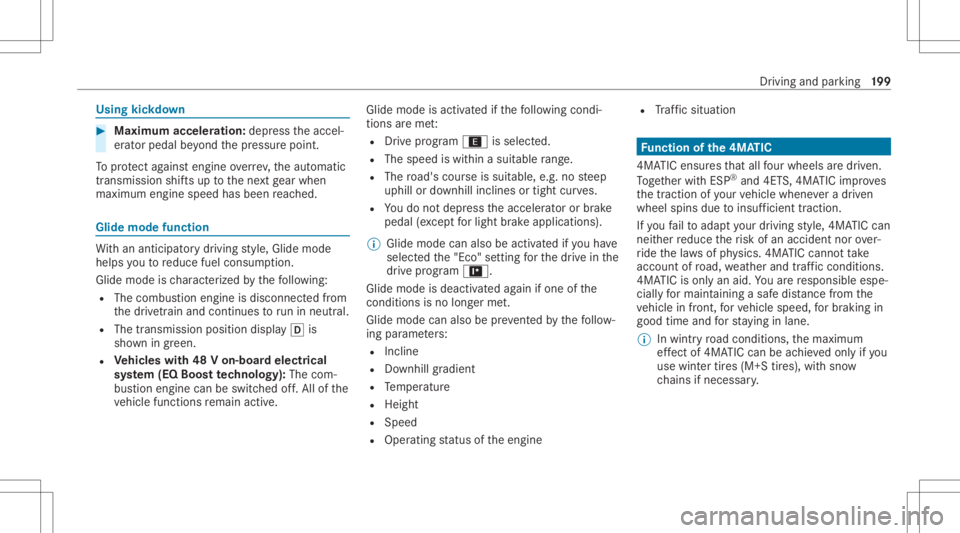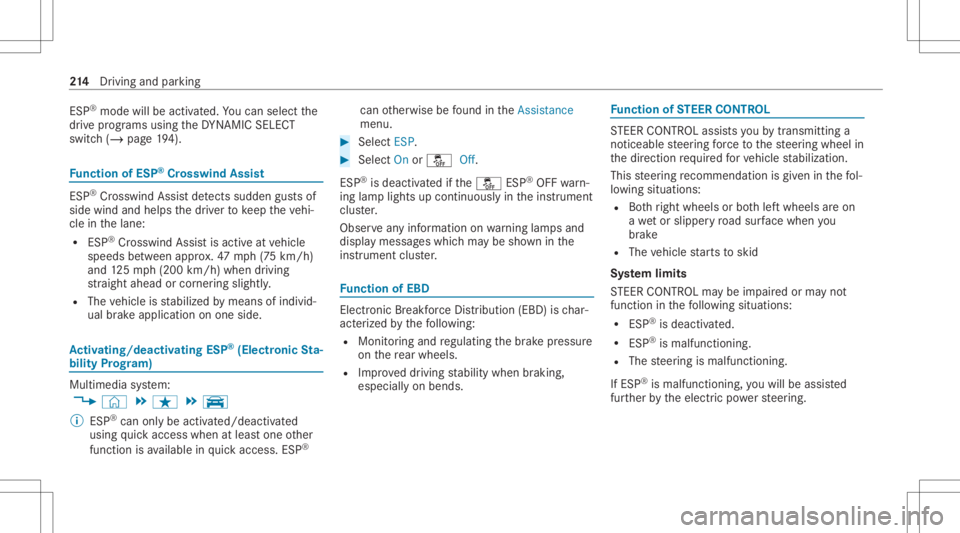2022 MERCEDES-BENZ S CLASS wheel
[x] Cancel search: wheelPage 191 of 610

To
remo vesalt build-up:
R brak eoccasionally whilepaying attention to
th etra ffic con dition s
R carefull ydepr essthebr ak epedal attheend
of thejour neyand when star tin gth ene xt
jour ney
No teson hydropl aning
Hyd roplaning cantake place onceacer tain
amount ofwa terhas accumu lated on thero ad
sur face.
Obs erve thefo llo wing notesdur ing heavyprecip‐
it ation orinconditions inwhic hhy droplaning
ma yocc ur:
R Reduce speed
R Avoid tireru ts
R Avoid sudden steer ing movements
R Brak ecar eful ly
% Alsoob ser vetheno teson regular lych ecking
wheels andtires (/ page365). No
teson driving through wateron the road
sur face
Wa terwhi chhas entered intoth eve hicle can
damag eth eengine, electricsand transmission .
Wa tercan alsoent ertheair intakeof theengine
and cause engine damage.
Obser vethefo llo wing ifyo umus tdr ive th ro ugh
wa ter:
R The water,when calm,ma yonl yre ac hth e
lo we redg eof theve hicle body.
R Drive at amaximum speedof6mp h
(1 0 km/ h);watercan other wise enterthe
ve hicle interior orengine compartment .
R Vehicles trave ling infront ,or onc omin gve hi‐
cles, cancreat ewav eswhic hma yex ceed the
maximu mper missi bledep thofthewa ter.
The braking effect of thebr ak es isreduced afte r
fo rd ing. Brak ecar efull ywhile paying attent ion to
th etraf fic condi tions untilbr aki ng powe rhas
been fullyrestor ed. Fu
nction ofrear axle steer ing The
rear axle steer ing isan electr omechanical
auxiliar yst eer ing onthere ar axle whichadjus ts
th esteer ing ofthere ar wheels accordin gto the
position ofthefront wheels, depending onthe
speed. Thisresults ingreat ermaneuv erabil ity
and improv ed driving stabilit y,e.g. when corner‐
ing.
Re ar axle steer ing has thefo llo wing charact eris‐
tic s:
R Reduced steer ing effort and turnin gra dius
re sulting inreduced parkingef fort
R Improve ddr iving stabilit y,e.g. when corner‐
ing
R Mor edir ect steer ing resulting inim prov ed
handling oftheve hicle
Obser vetheno teson sno wch ains andsnow
ch ain mode (/page36 6). Dr
ivin gand parking18
9
Page 192 of 610

ECO
star t/s topfunc tion EC
Ostar t/s topfunc tion
% Depe nding ontheengine, theEC Ostar t/
st op funct ionisno tav ailable inall drive pr o‐
gr ams. Observeth est atus displa yin the
dr iver displa yfo rth is.
The engin eis switc hedoffaut omat icallyin the
fo llo wing situat ionsifall vehicle conditions for
an aut omat iceng inestop areme t:
R Youbr ak eth eve hicle toast ands tillin trans ‐
miss ionposit ion005Bor005C.
R Vehicl eswith a48 Von-b oard electrical
sy stem: Youdepr essthebr ak epedal when
tra veling atalow speed.
If th esy stem has detected one ofthefo llo wing
situat ions,th eengine willnotst op:
R Youstop atast op sign andther eis no vehi‐
cle infront ofyou.
R The vehicle that stopped infront ofyou
st ar ts up again.
R Youman euver,tur nth esteer ing wheel
shar plyor eng agere ve rsege ar. %
Ifth esy stem detects anintellige nt stop
inhibit or,fo rex am ple, ast op sign, theengine
will notst op.
If yo uact ivat eth eHOLD function oreng age
th epar kposition 005D,theengine canbe
switc hedoffin spit eof an intellig entstop
inhibit or.
The engine isrestar tedaut omatic allyif:
R Youen gage trans missi on positio n005B or005E.
R Youdepr esstheacceler ator pedal.
R Anautomatic enginestar tis requ ired bythe
ve hicle.
R Youre lease thebr ak epedal.
R Vehicl eswith a48 Von-b oardele ctrical
sy stem:
- Youre lease thebr ak epedal onado wnhill
gr adient andtheve hicle does notro ll.
- The vehicle rolls on ado wnhill gradien t
and does notaut omat icallyent erglide
mode at15 mp h(2 0km/h). EC
Ostar t/ stop funct ionsymbols inthedr iver
displa y:
R The 00D6 symbol (green) appear swhen the
ve hicle isat ast ands till:The enginewas
switc hedoffby theEC Ostar t/ stop funct ion.
R The 00D5 symbol (yello w)appear swhen the
ve hicle isat ast ands till:No tall vehicle condi‐
tions foran engine stop have been met.
R Neit herthe00D6 nor00D5 symbol appears
when theve hicle isat ast ands till:An intelli‐
ge nt stop inhibit orwa sde tected, forex am‐
ple, ast op sign.
R The s symbol appears:The ECOstar t/
st op funct ionisdeactiv ated orther eis amal‐
func tion.
If th eengine wasswitc hedoffby theEC Ostar t/
st op funct ionand youlea vetheve hicle, awa rn‐
ing tone sou nds and theengine isno tre star ted.
In addition, thefo llo wing displa ymess age
appear sin thedr iver displa y:
Vehicle ReadytoDrive Switchthe Ignit ionOff
Befor eEx iting 19
0
Driving and parking
Page 200 of 610

Manual
gearshif ting When
theaut omatic transmiss ionisshif tedto
position 005B,youcan man uallyshif tit wit hth e
st eer ing wheel gearshif tpaddle. Ifper mitted, the
aut omat ictransm issionshif tsto ahigh eror
lo we rge ar depen dingon thesteer ing wheel
ge arshif tpaddle beingpulled.
Yo uha ve twoop tio ns tomanua lly shif tth eaut o‐
matic transmiss ion:
R Temp orar yse tting
R Perm anen tse tting
The gearsshif taut omat icallywhen manualshif t‐
ing isdeac tivated. Te
mp oraryse tting: #
Toactiv ate: pul lst eer ing wheel gearshif t
paddle 1or2.
Man ualshif tingis act ivat ed fora shor ttime.
The transmiss ionposi tion display sho ws0063
and thecur rent gear.
% Howlon gth emanual shifting stay sactiv ated
is dependent onvarious fact or s.
Ma nua lshi fting can beaut omat icallydeact i‐
va tedin thefo llo wing cases :
R Changin gth edr ive pr og ram
R Restar tin gth eve hicle
R When thetransmission position005Bis
eng aged again
R Driving style #
Toshif tup: pull steer ing wheel gearshif t
paddle 2. #
Toshif tdo wn: pullsteer ing wheel gearshif t
paddle 1. #
Todeac tivate: pullst eer ing wheel gearshif t
paddle 2and hold itin place .
The transm issionposit iondispla ysho ws005B. Pe
rm anen tse tting: #
Cha ngeto drive pr og ram =(/ page19 4). #
Select drive se tting 0063(/ page 194). Gear
shiftre comm endation The
gearshif tre comme ndation assists youin
adop tingan eco nomic aldrivin gst yle. #
Ifge arshif tre comme ndation 1appea rs
ne xt to thetra nsmiss ionposition display,
shif tto there comme ndedgear. 19
8
Driving and parking
Page 201 of 610

Using
kickdo wn #
Maxim umacceler ation:depresstheaccel‐
er ator pedal beyond thepr essur epoint .
To protect agains tengine overrev ,th eaut omatic
tra nsmiss ionshiftsup tothene xt gear when
max imum enginespee dhas been reac hed. Glid
emod efu ncti on Wi
th an ant icip ator ydr ivin gst yle, Glide mode
helps youto reduce fuelconsum ption.
Glide mode isch aract erize dby thefo llo wing:
R The com bustion engin eis disco nnect edfrom
th edr ivet ra in and continues torunin neu tral .
R The trans mis sion positio ndispl ay005B is
sho wningreen.
R Vehicl eswith 48Von-b oardele ctrical
sy stem (EQ Boos tte ch nology): Thecom‐
bus tion engine canbeswitc hedoff.All ofthe
ve hicle functionsremain active. Gli
de mode isactiv ated ifth efo llo wing condi‐
tion sar eme t:
R Drive pr og ram ; issele cted.
R The speed iswit hin asui table rang e.
R The road's courseissuit able, e.g.no steep
uphill ordownhill inclinesortight curves.
R Youdo notdepr esstheaccelera toror brak e
peda l(e xc ep tfo rlig ht brak eapp lications).
% Glide mode canalsobe activ ated ifyo uha ve
select edthe"Eco" setting forth edr ive in the
dr ive pr og ram =.
Gli de mode isdea ctivated again ifone ofthe
condi tions isno long erme t.
Gl ide mod ecan also be preve nted bythefo llo w‐
ing parame ters:
R Incline
R Downhill gradi ent
R Temp eratur e
R Height
R Speed
R Oper ating status oftheengine R
Traf fic situ ation Fu
nction ofthe4MA TIC
4MA TICensures that all four wheel sar edr iven .
To ge ther wit hES P®
and 4ETS,4MA TICimprove s
th etra ction ofyour vehicle whene vera dr iven
whee lspins duetoinsuf ficie nttracti on.
If yo ufa ilto adap tyo ur drivin gst yle, 4MA TICcan
neit her reduce therisk ofan accident norover‐
ri de thelaws ofphysics. 4MA TICcannotta ke
acc oun tof road, weather and traf fic condi tions.
4MA TICisonly anaid. Youar ere sponsible espe‐
cially formaint ainingasaf edis tance from the
ve hicle infront, forve hicle speed, forbr aking in
good timeandforst ay ing inlane.
% Inwint ryroad con dition s,themaximum
ef fect of 4MA TICcan beachie vedonl yif yo u
use wint ertires (M+ Stir es), withsn ow
ch ains ifnec essar y. Dr
iving and parking 19
9
Page 205 of 610

#
When leaving theve hicle, alwaysta ke
th eSmar tKey wit hyo uand lockth e
ve hicle. #
Keep theve hicle SmartKey out ofreac h
of childr en. *
NO
TEDama getotheve hicle duetoit
ro lling away #
Alw ayssecur eth eve hicle agains tro ll‐
ing away. *
NO
TEDama gedue totheve hicle lowe r‐
ing Ve
hicl eswith AIRMA TICorE-AC TIVE
BO DY CONT ROL:The vehicle canlowe r
because oftemp eratur edif fere nces orlong er
non-op erati ona ltime s.Thi scan causedam‐
ag eto par tsof thebody . #
When stopping theve hicle andwhen
dr iving off,mak esur eth at ther ear eno
obs tacle ssu ch ascur bsunde ror inthe
immed iatevicin ityofthebody . #
Bring theve hicle toast ands tillby pressing
th ebr ak epedal. #
Ongradients, turnth efront wheels sothat
th eve hicle willrollto wa rdsth ecurb ifit
st ar ts mo ving. #
App lytheelectr icpar king brak e. #
Engage trans missi on positio n005D inast atio n‐
ar yve hicle withth ebr ak epedal applied
(/ page19 7). #
Swi tchof fth eengine andtheignition by
pr essing button1. #
Release theser vice brak eslo wly. #
Getout oftheve hicle andlockit.
% When youpar kth eve hicle, youcan still
opera tetheside windo wsand thepanor amic
sliding sunroofforapp roxima tely four
min utes ifth edr iver's door isclosed. Gar
agedoor opener Pr
og rammin gbutt onsfo rthe garage doo r
ope ner &
DANG ER Risk ofdeat hcause dby
ex haus tga ses
Combus tionengines emitpoisonous exhaus t
ga ses suchas carbon monoxide.Inhaling
th ese exhaus tga ses ishazar dous tohealt h
and leads topoisonin g. Dr
iving andparking203
Page 214 of 610

R
ActiveEmerg encyStop Assis t(countr y-
dependen t)(/ page22 7)
R ActiveLa ne Chang eAssi st(coun try- depend‐
ent )(/ page229)
R ActiveSt op-and-Go Assist(countr y-depend‐
ent )(/ page225 )
R ActiveBli nd Spo tAssi stwit hex itwa rning
(/ page24 2)
R ActiveLa ne Keeping Assist(/ page24 6)
R PRE-S AFE®
Im pul seSide (/page58)
Pa rking Packag e
% The availabilit yof ind ividual function sis
coun try and equipme nt-de pen dent.
R Rear vie wcam era(/ page25 3)
R Surround viewcam era(/ page25 5)
R Parking AssistPA RK TRONI C(/ pag e26 0)
R ActivePa rking Assist(/ page263) Fu
nctions ofABS (Anti-loc kBr aking System) AB
Sre gulat esthebr ak epr essur ein critical driv‐
ing situation s:
R Dur ing braking, e.g.atmaximum full-stop
br aking orinsuf ficie nttiretracti on, the
wheels arepr eve nted from lock ing.
R Vehicle steer ability whilebraking isensur ed.
If ABS interve nes when braki ng, youwill feel a
pulsing inthebr ak epedal. Thepulsating brak e
pedal canbeanindicat ionofhazar dous road
con dition sand canserveas are minder totake
ex tra car ewh ile dr ivi ng.
Sy stem limit s
R ABSis act ive from speeds ofappr ox.3 mp h
(5 km/ h).
R ABSma ybe impair edorma yno tfunc tion ifa
malfunc tionhasoccurredand theye l‐
lo w 0025 ABSwa rning lam plight sup con tin‐
uousl yin theins trument clusteraf te rth e
engine isstar ted. Fu
nction ofBA S &
WARNIN GRisk ofan acci dent caused by
a malf unctionin BA S(Br akeAssi stSys‐
te m)
If BA Sis mal functi oning,th ebr aking distance
in an eme rgency braki ng situa tionis
incr eased . #
Dep ress thebr ak epedal withfull forc e
in emer gency braki ng situa tions. ABS
pr eve nts thewheels from locking . The
Brak eAssis tSy stem (BAS )suppor tsyour
eme rgency braking situation withadditional
br ak efo rc e.
If yo udepr essthebr ak epedal quickl y, BA Sis
acti vated:
R BASau tomatical lyboos tsthebr ak epr es‐
sur e.
R BAScan shorten thebr aking distance.
R ABS preve nts thewheels from locking .
The brak es will func tion asusual onceyo u
re lease thebr ak epedal. BASis dea ctivated. 21
2
Driving and parking
Page 215 of 610

Fu
nction ofESP ®
(Electr onicStabil ityPro‐
gr am) &
WARNIN GRisk ofskid ding ifESP ®
is
dea ctivated
If yo udeac tivateES P®
,ES P®
can notcar ry
out vehicle stabiliz ation. #
ESP®
shoul don lybe deactiv ated inthe
fo llo wing situat ions. ES
P®
can mon itor and improve driving stabilit y
and tract ion inthefo llo wing situat ions,wit hin
ph ysical limit s:
R When pulling away on awe tor slip pe ry road.
R When brakin g.
If th eve hicle deviat esfrom thedir ect ion desir ed
by thedr iver ,ES P®
can stabiliz eth eve hicle by
int erve ning inthefo llo wing ways:
R One ormor ewheels arebr ak ed.
R The engine outputisadap tedaccor dingto
th esituation . When
ESP®
is deactiv ated, the00BB warning
lam plight sup con tinuousl y:
R Drivin gst abilit ywill nolongerbe improve d.
R The drive wheels couldspin.
R ETS/4 ETStra ction control isstill act ive.
% When ESP®
is deact ivat ed, youar est ill assis‐
te dby ESP ®
wh en braki ng.
Wh enthe00E5 warning lam pflashes ,on eor
se veralwheels hasreac hed itsgrip limit :
R Adaptyo ur drivin gst yle to suit thecur rent
ro ad and weather condition s.
R Donotdeac tivateES P®
.
R Onlyde pres sth eacceler ator pedal asfaras
is necessar ywhen pulling away.
Dea ctivateESP ®
in thefo llo wing situat ionsto
im prove tracti on:
R Whenusing snowch ains .
R Indeep snow .
R Onsand orgrav el. %
Spinn ingthewheels results inacutting
action, whichenhances traction.
If th e00E5 ESP®
wa rning lam plight sup con tinu‐
ousl y,ESP ®
is no tav ailable duetoamalf unction.
Obse rveth efo llo wing informatio n:
R Warning and indic ator lam ps(/ page553 )
R Disp lay mess ages (/ page495)
ET S/4ET S(Electr onicTractio nSy stem)
ET S/ 4ETS tracti oncontr olispa rtof ESP ®
and
mak esitpossible topull away and accelerat eon
a slippe ryroad.
ET S/ 4ETS can improve theve hicle's traction by
int erve ning inthefo llo wing ways:
R The drive wheels arebr ak ed individually if
th ey spin.
R Mor edr ive to rq ue istrans ferred tothewheel
or wheels withtra ction.
Inf luence ofdrive pr og rams onESP®
The drive pr og rams enabl eESP ®
to adap tto dif‐
fe re nt we ather and road con dition sas wellas
th edr iver's prefer reddr iving style. Depen dingon
th eselect eddrive pr ogr am, theappr opriate Dr
iving andparking 21
3
Page 216 of 610

ESP
®
mod ewi llbe acti vated. Youcan selectthe
dr ive pr ogr ams using theDY NA MIC SELE CT
switc h(/ page19 4). Fu
nction ofESP ®
Cr osswind Assist ES
P®
Cr osswind Assistde tects sudde ngu stsof
side wind andhelps thedr iver tokeep theve hi‐
cle inthelane:
R ESP®
Cr osswind Assistis activ eat vehicle
speeds between appr ox.47 mp h(7 5 km/h)
and 125mp h(2 00 km/h) whendr iving
st ra ight ahead orcor ner ing slight ly.
R The vehicle isstabiliz edbymeans ofindivi d‐
ua lbr ak eapp lication onone side. Ac
tiv atin g/deac tivatin gES P®
(E lectr onicSta‐
bil ity Prog ram) Mu
ltimed iasystem:
4 © 5
ß 5
y
% ESP®
can onlybe activ ated/deact ivat ed
using quick acc ess when atleas tone other
funct ionisavailable inqu ick acc ess. ESP® can
other wise befound intheAssist ance
menu. #
Select ESP. #
Select Onor00BB Off.
ES P®
is deactiv ated ifth e00BB ESP®
OFF warn‐
ing lam plight sup con tinuousl yin theins trument
clus ter.
Obser veanyinf ormat iononwarning lam psand
displa ymess ages whic hma ybe sho wninthe
ins trumen tclus ter. Fu
nction ofEBD Elect
ronic Brea kfor ce Dis trib uti on (EBD) isch ar‐
act erize dby thefo llo wing:
R Mon itor ing and regulating thebr ak epr essur e
on there ar wheels .
R Improve ddr iving stabilit ywhen brakin g,
espe ciallyon ben ds. Fu
nction ofSTEER CONT ROL ST
EER CONTR OLassist syo uby trans mitting a
no tice ablesteer ing forc eto thesteer ing wheel in
th edir ect ion requ ired forve hicle stabiliz ation.
This steer ing recomme ndation isgiv en inthefo l‐
lo wing situat ions:
R Both right wheels orboth leftwheels areon
a we tor slip pe ry road sur face whe nyo u
br ak e
R The vehicle star ts to skid
Sy stem limit s
ST EER CONTR OLmaybe impai redor ma yno t
func tion inthefo llo wing situat ions:
R ESP®
is deact ivat ed.
R ESP®
is malfun ctionin g.
R The steer ing ismalfunct ioning.
If ES P®
is malfunct ioning,youwill beassis ted
fur ther by theelectr icpo we rst eer ing. 21
4
Driving and parking